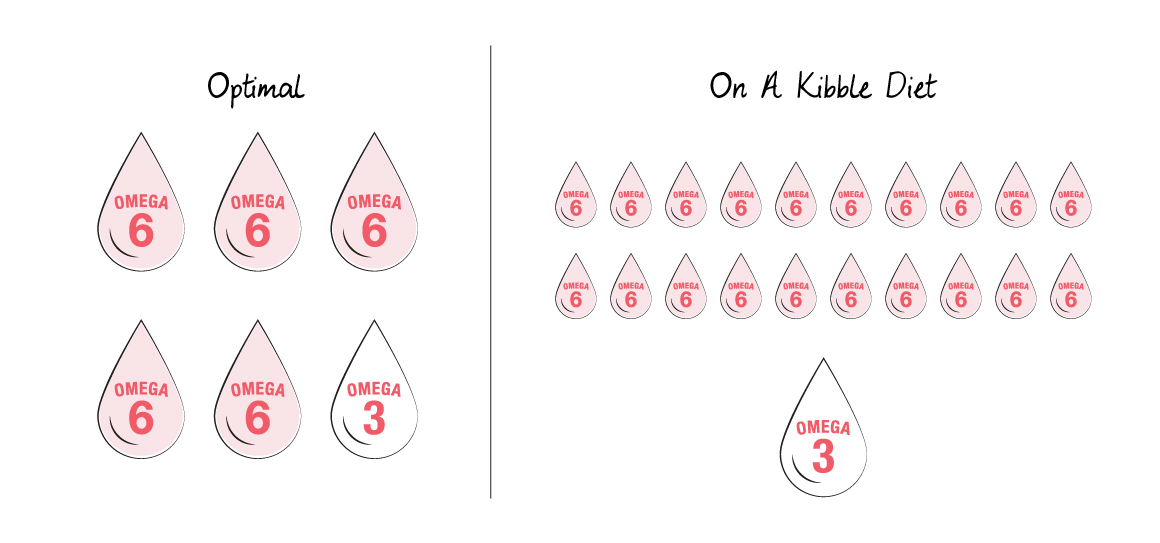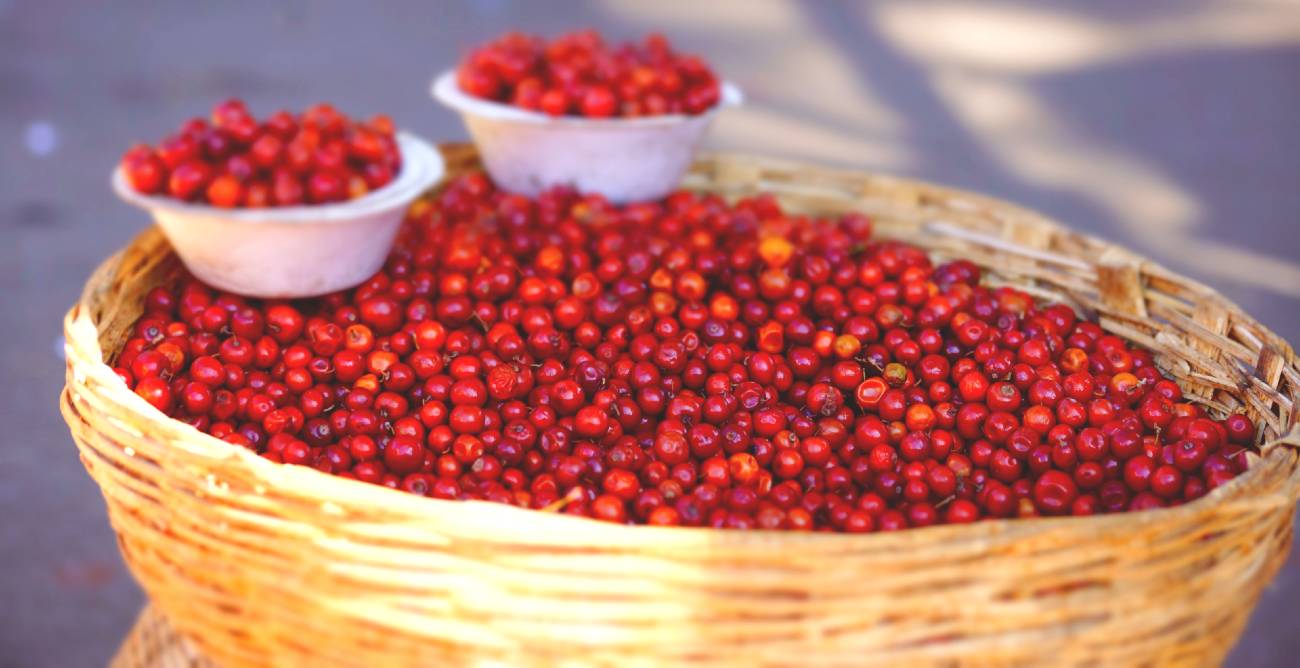Your dog is itchy, like itchhhhy, itchy because of his seasonal allergies and you want to offer any kind of relief you can, so you start with what’s in his bowl. Good on you!
You’re searching for the best dog foods, but here’s the thing. Every single dry dog food, the limited ingredient, the grain-free, and hypoallergenic varieties claiming to be the solution– can actually make your allergy dog’s incessant itch worse.
Here’s why…

On The Agenda
Your Hot, Inflamed Allergy Dog
Allergies happen when your pup’s got a hypersensitivity. Maybe it’s environmental, maybe it’s from food or contact, but in its simplest form, it’s a hyper-reaction, one that occurs when our bodies and our pet’s bodies hyper or over-react to allergens. And it’s this response that creates heat and inflammation and causes uncomfortable symptoms.
For a dog experiencing seasonal allergies, heat and inflammation are expressed in the skin, causing that incessant urge to scratch, itch, bite, and itch some more.
So, as you consider what to put in the bowl, know that dog food or kibble actually contributes to inflammation. And that just makes everything worse for your allergy dog.

How Kibble Promotes Inflammation & Contributes to Symptoms
Kibble is certainly convenient to feed your pet. Scoop ‘n serve. But kibble is like junk food. It tastes delicious, it’s easy to get, and it’s cheap. When it comes down to it, kibble is seriously lacking in the nutrients that your pet needs and heavy-handed with ingredients he’d do best without.
Kibble Contains Too Many Carbs
Read through an ingredient label, and you’ll find ingredients like beet pulp, soy, barley. Dry food recipes like these contain anywhere from 40-60% carbs. What amount should your pet eat? More like 20% or less. I don’t have to tell you there’s a big discrepancy there. Too many carbs may not seem like that big of a deal. But for the scavenger carnivore that your dog is, it actually is.
But why does carb count matter, anyway? Because your dog, the carnivore, isn’t physically equipped to handle a high-carb diet.
Feeding pro-inflammatory food like carb-heavy kibble to an already hot, inflamed dog with an overactive immune system is truly like adding kerosene to a house already ablaze. You fan the heat and flame as it laps the walls.

In Kibble Recipes, Omega 3:6 Ratios Are Abysmal
Fat is an essential part of your dog’s diet. But it’s the ratio of Omega-3 fatty acids from EPA and DHA to Omega-6 fatty acids, that’s key. The ideal ratio for your dog is 1:1, but anything in the range of 5:1 Omega 6:3 fatty acids is healthy. Kibble, comes nowhere close to those numbers. Recipes include upwards of 20:1 Omega 6:3 Fatty Acids.

Too much Omega 6 without enough Omega 3 to balance it out can lead to uncontrolled inflammation and a long list of chronic health conditions ranging from diabetes to GI issues to cancer.
Not to mention, it exacerbates existing conditions. The itchy dog becomes even itchier because they’re missing essential nutrients. And the allergy dog becomes even more miserable because, again, it’s contributing to heat and inflammation.
But the good news is, you can help relieve those uncomfortable symptoms by avoiding kibble. And instead, feeding a diet curated for the allergy dog.
What To Put In The Allergy Dog’s Bowl Instead
You are what you eat. There’s no way around it. And a species-specific diet is exactly what your allergy pet needs, well, really what every pet needs.
Start With The Right Diet
It can be tough to know exactly where to start when it comes to choosing food for your allergy dog. The most important thing to keep in mind is that choosing appropriate food is the first step!
But, what is a species-appropriate diet? Here’s a little checklist to keep in mind:
- Well for one, it should start with real, whole foods. It should be high-protein, low-carb, and have the correct ratio of Omega 3 to Omega 6 fatty acids – 1:1, ideally.
- Look for a recipe with real ingredients that you recognize, and a short ingredient list at that.
- The formula should include 70-80% animal protein with skeletal meats and organs. Emphasis on the animal in animal protein!
- Also, go low-carb, and feed a diet with 25% or fewer carbs from nutrient-rich fruits, veggies and seeds.

Again, these are the VERY basics. The start of your bowl building, but a crucial first step. There’s more to do for a bowl curated with your pup’s unique needs in mind.
Nurture the Skin With The Right Type of Omega 3 and Omega 6 Fatty Acids
It’s important to feed your dog a diet rich in essential Omega 3 EPA & DHA fatty acids and Omega 6 fatty acids. And not just during allergy season!
That said, it’s the type of Omega 3 and Omega 6 fatty acids that are key to helping your allergy dog. Here’s a breakdown:
Types of Omega 3 Fatty Acids:
- EPA, or Eicosapentaenoic acid
- ALA, or alpha linoleic acid
- DHA, or Docosahexaenoic acid
Types of Omega 6 Fatty Acids:
- GLA, or Gamma linoleic
- CLA, or Conjugated linoleic acid
- LA, or Linoleic acid
- ARA, or Arachidonic Acid

Omega 3 EPA and DHA fatty acids are active, ready-to-use forms of Omega 3—and that’s exactly why your allergy dog needs these in his diet.
Omega 6 fatty acids provide an excellent source of healthy fat and energy for your pup. But, it’s important they’re fed in moderation. Remember that balance– too many Omega 6s to 3s can cause more inflammation for the allergy dog.
Instead of adding as many Omega 6s to the bowl as possible, opt for a specific type– GLA. Why? Because it strengthens skin integrity AND it’s the only type of Omega 6 that’s anti-inflammatory. It’s a staple for every allergy dog and can be added to your pet’s dish from quality sources like borage oil and primrose oil.

Choose Cooling Foods for the Hot Dog
Did you know that every food is either hot, cold, or neutral? We’re talking food energetics. And cooling foods, well, they do exactly that. Cool down excessive heat and inflammation in the body.

Opt for cooling foods– for proteins, choose rabbit, duck, or fish, for cooling fruits and veggies include broccoli or tomatoes. You can find a full list of cooling foods here.
On the flip side, that means you should take care to avoid foods that fall under the ‘warm’ food umbrella. Adding hot foods to your pet’s diet is like adding fuel to the fire. It adds more heat to an already inflamed environment. Phew, getting hot just thinking about it.
Some warm foods to avoid include turkey, chicken, lamb, black beans, sweet potato, peaches, oats, and coconut, to name a few. Again, check out the full list here.
Add Milk Thistle and Anti-Inflammatory Herbs
So far, you’ve got cooling foods in the bowl, nutraceuticals like EPA, DHA, & GLA from Omega fatty acids, and now you should reach for targeted herbs, starting with Milk Thistle.
Add Milk Thistle to the mix when your pet’s experiencing an allergic reaction. It’s hepatoprotective….which is just a fancy way to say that it’s got your liver’s back. Not only does it protect the liver, but it also helps the liver build new, healthy cells. Detoxification also helps relieve heat and inflammation, so it’s one piece in the nutrition puzzle for the allergy dog!
Plus, if your pup’s allergies are so severe they require pharmaceuticals, Milk Thistle’s even more essential. It helps the liver flush out antihistamines, steroids, and other allergy treatments. It’s there to repair all that damage after a hypersensitivity reaction.

Combine Cooling and Calming Herbs With Yin-Tonifying Herbs
This allows you to address the root cause of your four-legger’s allergies. Heat-draining herbs help bring down the heat and inflammation, helping to bring your pet back to homeostasis.
Yin-tonifying herbs help your pet’s body replenish fluids and effectively help protect the existing fluids in the body to work towards a balanced state.
It’s aggravating to be THAT unbelievably itchy, so the mixture of calming herbs helps your pet relax and calm down, so they aren’t so tempted to scratch that itch.

So, a recap of how to curate your seasonal allergy dog’s bowl
- Start with a species appropriate diet preferably a cooling recipe
- Add in the right essential fatty acids (EPA, DHA, GLA)
- Don’t forget the Milk thistle
- And of course, the combination of cooling, calming and yin-tonifying herbs
Pro(active) Tip: If it’s seasonal… start 2-3 months before allergy season.
And, of course, if you’re still not entirely sure where to start, take the quiz for a personalized recommendation.
Share this Post

Dr. Chris Besent
Chris Bessent, DVM, MSOM, Dipl. OM, L.Ac. has over thirty years of experience in veterinary medicine including certificates in veterinary acupuncture, veterinary chiropractic and veterinary Chinese herbology. Imbued with Eastern philosophy and the knowledge that food is the foundation of health, Dr. Bessent also received her degree in veterinary nutrition and began to formulate recipes fit for a carnivore from nothing but whole foods. Currently, she divides her time between the Simple Food Project and Herbsmith, both of which are owned and operated out of her facilities in southeastern Wisconsin.

Kira - Writer
Kira is a writer who lives in Montana. She takes advantage of the mountains and river—and spends a lot of time outdoors. She has a giant shaggy dog who’s the perfect sidekick. And spends her free time making things. Crafting, sewing, and jewelry making are favorites!

Kayla - Editor
Kayla is the Content Editor for Herbsmith. She has a cat named Professor Cat-Faced Meowmers, who goes by Kitty, and a goof of a dog, named Duck. She stays busy biking trails, playing board games, and searching for the next best craft beer.




